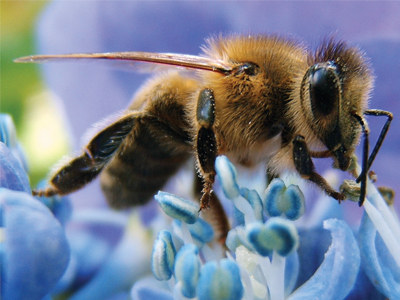MCP: We shall know thine enemy, honey bee
Varroa destructor is appropriately named, given the havoc it wreaks on colonies of western honey bees. Since it first arrived in Florida in the 1980s, the parasitic mite has pushed bee colonies across North America to ruin, and it is believed to be the most significant contributor to the recent spike in colony deaths in the United States and Canada. Despite the scope of the mite’s damage, however, surprisingly little is known about its inner molecular workings.
 A western honey bee rests on a flower. RICKS/WIKIMEDIA COMMONS
A western honey bee rests on a flower. RICKS/WIKIMEDIA COMMONS
As a first step in ultimately combating this bee-barian, researchers in the lab of Leonard Foster at the University of British Columbia in Canada have published a protein atlas in Molecular & Cellular Proteomics that details 1,433 differentially expressed proteins across the various developmental stages of V. destructor.
“One thing that a lot of people who are studying model systems or human systems don’t really appreciate is that when you move outside of those model systems and try to understand something at a molecular level about an organism without that huge body of knowledge that has been built over the years in that particular organism, you really don’t have any idea where to start,” Foster said. With this in mind, Foster and colleagues, including graduate student Alison McAfee, set out to create a document of the entire proteome that the male and female mites might produce throughout their life cycles.
“It’s a tool that other researchers can use to come up with their own questions about Varroa biology,” said McAfee, whose research focuses on the defense mechanisms bees mount against the mites.
In addition to quantifying the mites’ proteins, the researchers found that males and females expressed proteins involved in chromatin remodeling differently.
“Very little is known about the sex determination system in Varroa,” McAfee said. “Part of what that might be pointing to is the mites exposing different parts of the DNA to express more sex-specific proteins.”
The harm that V. destructor inflicts on honey bees is multifold; in addition to feasting on the bees’ blood and leaving open wounds ripe for infection, the mites are vectors for the deformed wing virus, which cripples wing growth in developing honey-bee pupae.
The scope of damage from mites is a consequence of abrupt introductions — the longer a host and parasite have coexisted and coevolved, the more harmonious, if still exploitative, their relationship will be.
Such is the case with V. destructor and its original host, the Asian honey bee, which have had millions of years to get to know one another. However, V. destructor and its viruses have just barely begun to make evolutionary introductions with honey bees, giving their new hosts few genetic weapons to fight them off.
According to Foster, Varroa’s use of odorant-binding proteins is likely key to their predatory interactions.
“Varroa have to be able to detect bees of certain ages, and this has to depend on odors,” he said. “At some point, we will want to try to define the molecular mechanism that is underlying that interaction, and knowing which proteins are expressed in which stages in the Varroa will be important for that eventual understanding.”
Enjoy reading ASBMB Today?
Become a member to receive the print edition four times a year and the digital edition monthly.
Learn moreGet the latest from ASBMB Today
Enter your email address, and we’ll send you a weekly email with recent articles, interviews and more.
Latest in Science
Science highlights or most popular articles

E-cigarettes drive irreversible lung damage via free radicals
E-cigarettes are often thought to be safer because they lack many of the carcinogens found in tobacco cigarettes. However, scientists recently found that exposure to e-cigarette vapor can cause severe, irreversible lung damage.

Using DNA barcodes to capture local biodiversity
Undergraduate at the University of California, Santa Barbara, leads citizen science initiative to engage the public in DNA barcoding to catalog local biodiversity, fostering community involvement in science.

Targeting Toxoplasma parasites and their protein accomplices
Researchers identify that a Toxoplasma gondii enzyme drives parasite's survival. Read more about this recent study from the Journal of Lipid Research.

Scavenger protein receptor aids the transport of lipoproteins
Scientists elucidated how two major splice variants of scavenger receptors affect cellular localization in endothelial cells. Read more about this recent study from the Journal of Lipid Research.

Fat cells are a culprit in osteoporosis
Scientists reveal that lipid transfer from bone marrow adipocytes to osteoblasts impairs bone formation by downregulating osteogenic proteins and inducing ferroptosis. Read more about this recent study from the Journal of Lipid Research.

Unraveling oncogenesis: What makes cancer tick?
Learn about the ASBMB 2025 symposium on oncogenic hubs: chromatin regulatory and transcriptional complexes in cancer.

